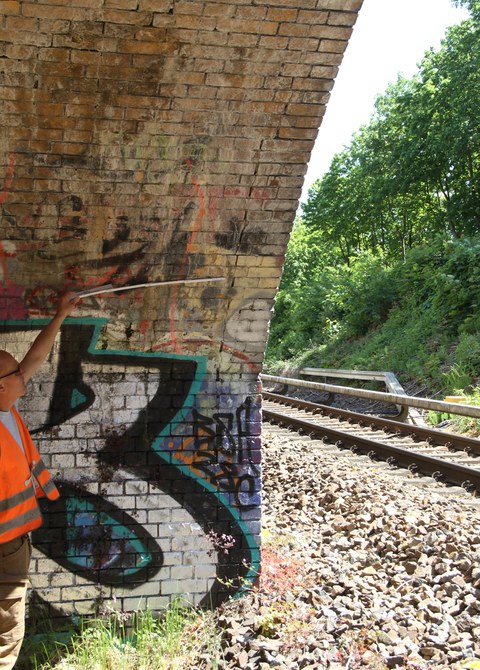Structural diagnosis on vault bridges
Table of contents
Project data
| Titel | Title Bauwerksdiagnose an Gewölbebrücken | Structural diagnosis on vault bridges Auftraggeber | Client DB Netz AG, Standorte Hannover, Nürnberg, Berlin und Leipzig Zeitraum | Period Seit | Since 04/2022 Projektleiter | Project manager Prof. Dr.-Ing. Steffen Marx Team | Team Dr.-Ing. Torsten Hampel, Dipl.-Ing. (FH) Sabine Liebelt |
Report 2023
Bridge diagnostics for a longer service life

Damage documentation at an arch bridge in Berlin
Today, there are more than 4000 arch and vault bridges in the existing network of Deutsche Bahn (DB). Quite a few are more than 100 years old, some have even been in operation for 150 years. Since their construction, loads and traffic density have often increased. If these structures can be upgraded to meet current and future requirements instead of having to be replaced, this would not only be of considerable economic benefit to DB AG but would also meet sustainability criteria.
Taking the sheer number of vault bridges in the existing stock into account, it was decided to standardize the approach to this problem. The result was a two-stage building diagnostics. In stage 1, the boundary conditions and specifics of the structure are to be assessed. Then, in stage 2, the parameters and properties of the materials used and the special features of the superstructure and the substructure have to worked out using suitable methods. Based on these data, a meaningful renovation concept for the bridges can then be created in a subsequent step.
In order to ensure the expertise of the executing companies, DB AG launched a prequalification process and a framework agreement was drawn up, as a result of which six testing institutes were bound. The DB Netz AG – Foundation Professorship for Civil Engineering at the TU Dresden is one of these institutions. Within the year 2023, we examined a wide variety of structures, in particular vaulted bridges. In specific, locations for drilling cores for the determination of material properties were defined, possible areas for the construction site equipment and accessibility were explored and, as the main output, calculation values for the static modeling were determined.
In this way, the project made a contribution to preserving the bridges, some of which are historic, and making them fit for rail traffic for another 50 years.
